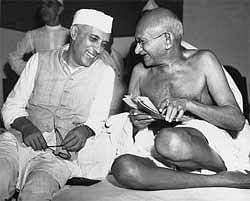
An armful of such documents - some fading with age - grainy, black-and-white photographs and press clippings at the National Archives of India bear testimony to the events that led to the creation of a free India 63 years ago and a sovereign republic three years later in 1950.
A two-month exhibition 'Independence To Republic' at the National Archives of India that opened Aug 14 captures India's journey from 'Poorna Swaraj' to a sovereign republic in 1950 with the adoption of the constitution in an ode to the country's 64th Independence Day.
“The exhibition highlights the tortuous career of our Independence and the remarkable journey to a Republic. It is not so much about Independence, but about the Republic of India. This is the third exhibition in two months," Mushirul Hasan, director general of the National Archives of India, told IANS.
"We are planning a series of exhibitions. The next one will be on Commonwealth Games. It will exhibit documents related to the Games held in the Commonwealth nations. The Commonwealth showcase will be followed by two more exhibitions on Rajendra Prasad and Dadabhai Naoroji,” he added.
“We have just received the Manuben diaries (papers) in Gujarati from a private collector. They have large number of letters from Gandhiji," Hasan said.
Manuben was the wife of Mahatma Gandhi's grand-nephew Joysukhlal Gandhi.
The exhibition is a virtual walk through unusual nuggets of India's freedom struggle.
“Some of the exhibits have not been displayed before,” Hasan said.
For instance, in 1946, the question of seating arrangements in the Constituent Assembly's Hall presented some “difficulties”. Rajendra Prasad directed that the seating plan should be arranged in the order in which the provinces were listed in the Government of India Act, 1935.
The Press Gallery Committee suggested that the foreign correspondents admitted to the Constituent Assembly should be segregated from the domestic media. B.C Rao, the constitutional advisor to Rajendra Prasad, thought that the suggestion was kind of in retaliation to the discourteous treatment of the Indian press correspondents at certain foreign conferences.
Rajendra Prasad disapproved of the proposal because “it was contrary to Indian hospitality”. The controversy is documented in a bunch of frayed missives.
A hand-written letter dated Jan 14, 1950 from Nagpur-based astrologer N.K. Behera, “forwarded the horoscope or 'janam kundali' of India to Rajendra Prasad saying January 26, 1950 was an auspicious day to declare India a republic under an ascendant Aries in the full moon period”.
On Jan 23, 1950, then prime minister Jawaharlal Nehru wrote to Rajendra Prasad that “... we have laid down a formal dress code for our own ambassadors... The dress is a black 'achkan (bandhgulla) and 'churidar payjama (tight pants)'. Personally, I wear it at night and on other occasions. The practice is growing...”
Among other exhibits are copies of the judgment of Justice Khosla on the Mahatma Gandhi murder trial and a Jan 30, 1948 FIR on the assassination of the Father of the Nation.
The highlights also include dogeared copies of the Government of India Act, 1935, a message of the viceroy dated May 17, 1946 on the proposal of the Cabinet Mission delegation, a 1947 confidential letter announcing the swearing-in of Lord Mountbatten, the minutes of the first Constituent Assembly meeting, a letter from Nehru to Rajendra Prasad on the promulgation of the Republic and several more.
The exhibition is divided into five sections - Poorna Swaraj, Foundation of the Constitution, Transitional Turmoil, Independence At Last and Making of the Republic in a chronological sequence.